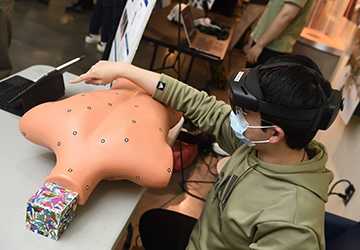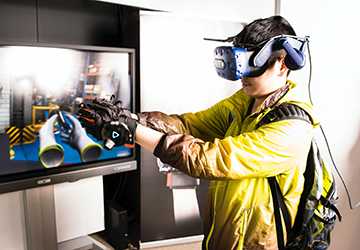What is Augmented Reality and How to Create It?
AR is becoming very important in many industries. This is due to the ability to merge the physical and virtual worlds. Products cover gaming, education, healthcare, manufacturing and advertising. AR improves the consumer experience. The technology can also increase productivity and provide answers to complex real-world situations.
AR is becoming very important in many industries. This is due to the ability to merge the physical and virtual worlds. Products cover gaming, education, healthcare, manufacturing and advertising. AR improves the consumer experience. The technology can also increase productivity and provide answers to complex real-world situations.
Creating AR involves both hardware and software technologies. Developers use specialized tools and systems to design and install augmented reality programs. Proper planning of UI design, application development and testing is required. So you get a high-quality experience.

Augmented reality technology
Augmented reality and virtual reality are all about immersion. Virtual reality (VR) removes the user from the physical environment. In contrast, augmented reality (AR) overlays digital information. It is higher than the material world. AR supplements human perception but does not replace the surrounding environment.
The development and history of AR
The development of AR technology can be traced back to the 1960s. AR is taking off with the early development of images generated by head-mounted displays and laptops. However, it was used in the 21st century.
AR gained popularity with the advent of smartphones and sensor technology. Notable milestones include AR apps like Pokémon Go. It brings AR into the mainstream.
Critical components of AR systems
Every system is made up of critical components. These components make up the hardware and software components:
Hardware components
The successful implementation of augmented reality benefits from advanced hardware components. It enables the seamless integration of virtual content into reality. It consists of sensors and processing equipment.
Smartphones: Smartphones come with high-resolution screens. Smartphones are a universal platform for AR programs.
Camera: Capture real-world environments. It allows computers to display imaginative images.
Accelerometer and gyroscope: Measure tool motion and orientation for precise spatial mapping.
GPS module: Provides environmental datasets for location-based AR packages.
Central Processing Unit (CPU): A software program algorithm that performs information processing.
Graphics Processing Unit (GPU): Processes 3D images and ensures clear visualization.
Artificial Intelligence (AI) Chips: The ability to speed up systems to improve AR applications.
Software components
Software components are crucial in augmented reality. It includes frameworks, programming languages, and PC vision technologies.
ARKit (iOS): Apple's framework for creating AR assessments on iOS devices.
ARCore (Android): Google's corresponding product for Android devices, providing AR development equipment.
Unity and Unreal Engine: Popular game development engines that help improve AR applications.
Swift (iOS), Java (Android), and C#: Programming languages for developing AR applications.
JavaScript: for web-based AR assessment to improve accessibility.
Object detection: Algorithms sense and identify natural objects. It allows virtual overlays to interact.
Development of AR/VR
Now let's discuss what the augmented reality process includes:
Planning the AR development process
Before starting AR development, planning is crucial. Have a plan in place to maintain the quality of your augmented reality. It would help if you did the following:
Know your audience: You should know your audience when developing AR. It defines their needs and goals.
User Experience (UX): UX is the most critical factor in design. You create AR for your audience to meet their needs. User-friendly interface improves user experience.
Design AR interface
People use engaging software or apps. That's why writing an attractive interface is essential. Add visual elements to stop scrolling.
User Interface (UI): Creative thinking is crucial in designing user-friendly interfaces. Visual clutter can be distracting. Therefore, these features are integrated into one smooth pattern.
3D Modeling and Animation: Augmented reality uses overlay technology to display digital features in the real world. It's like a 3D model or animation. A mixture of natural and virtual worlds interact with the environment.

Test augmented reality
After the development process is complete, the next step is testing. Testing ensures that the system is error-free. Maintaining the functionality of AR is very important. Testing includes functionality, usability and efficiency.
Usability testing: Because you are in an immersive state, there is a chance you may experience a headache or have a seizure. Usability testing is crucial. The purpose of these tests is to reduce inconvenience and improve user experience.
Debugging and Troubleshooting: AR connects users to real and virtual worlds. To improve the immersive experience, a testing process was conducted. It detects technical errors or bugs in the system.
Augmented reality tools
Many tools are available to you for developing augmented reality (AR). It provides the necessary infrastructure and resources for developing immersive and interactive AR. These structures improve the functionality of the device. Here, we provide an overview of well-known AR platforms and tools. It includes ARKit and ARCore.
ARKit(iOS)
Apple developed ARKit. It is a powerful AR platform designed specifically for iOS devices. It provides developers with comprehensive tools and APIs. This improves the AR experience on iPhones and iPads.
ARKit features also include motion and environment monitoring and lighting. This is the best way to develop immersive AR technology.
ARCore (Android)
Google's ARCore is the counterpart to ARKit. This is a customizable method for Android devices. Developers create AR apps that run on all types of Android smartphones. ARCore supports motion tracking, environmental information, and advanced photos.
Furthermore, video games are known all over the world. If you're bored, play games. It makes your mind relax. Unreal Engine is used to create video games. Developers use AR kits and cores to engage players through visual elements.
Additionally, developers create 2D and 3D images. Using Unity, you can create beautiful graphics. It's easy. You have to know how to use the Engine. The tool also works with ARkit and ARcore.
Diploma
You now know about augmented reality. Everyone needs change. The same goes for you. That's why AR developers created this immersive technology. It helps users experience the virtual world.
Making AR takes work. It requires knowledge of software and tools. However, this is more than just a problem for AR development. The next step is testing. You need to test before you can bring your product to market. So please read the guide above so that you understand the development process.





